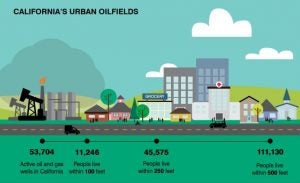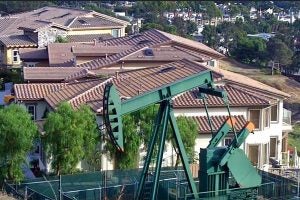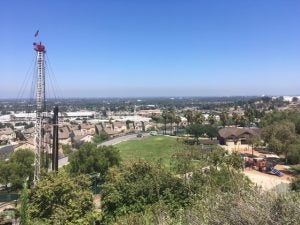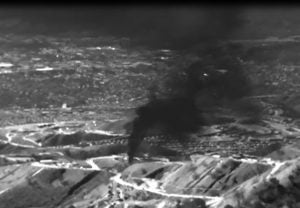 There are several reasons to be optimistic about environmental progress in Los Angeles. The city is making massive investments in electric vehicles, making clean energy more accessible to everyday people, and cutting pollution from the ports and freeways to name a few. But with over 60,000 Angelinos living less than 500 feet from an active oil well – LA could do more to protect our health and our environment.
There are several reasons to be optimistic about environmental progress in Los Angeles. The city is making massive investments in electric vehicles, making clean energy more accessible to everyday people, and cutting pollution from the ports and freeways to name a few. But with over 60,000 Angelinos living less than 500 feet from an active oil well – LA could do more to protect our health and our environment.
Oil and gas wells emit toxic chemicals that can increase our risk of developing asthma, cancer and other health problems. Recent studies by the California Air Resources Board and South Coast Air Quality Management District have uncovered elevated levels of benzene, a cancer causing agent, and other toxic compounds coming from oil and gas equipment in Huntington Beach and Signal Hill. In Santa Fe Springs a rupture at an oil site coated numerous homes with oil and generated noxious odors. Then there are the communities in Culver City, South LA, Compton and elsewhere living mere feet from drill sites who experience odors and health ailments on a regular basis. Most notoriously, the Porter Ranch community next to the Aliso Canyon gas field still reports respiratory problems and other symptoms stemming from a major gas leak in 2015.












 Since the 1892 discovery of oil in California, the oil and gas industry has been a major economic engine and energy supplier for the state. Although this oil and gas production may be broken down into dollars and barrels, it doesn’t tell the story of the potential impact of drilling activity on the lives of the people in Los Angeles and the Central Valley who live right next to these operations.
Since the 1892 discovery of oil in California, the oil and gas industry has been a major economic engine and energy supplier for the state. Although this oil and gas production may be broken down into dollars and barrels, it doesn’t tell the story of the potential impact of drilling activity on the lives of the people in Los Angeles and the Central Valley who live right next to these operations.
